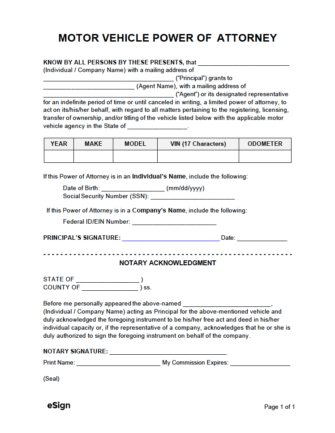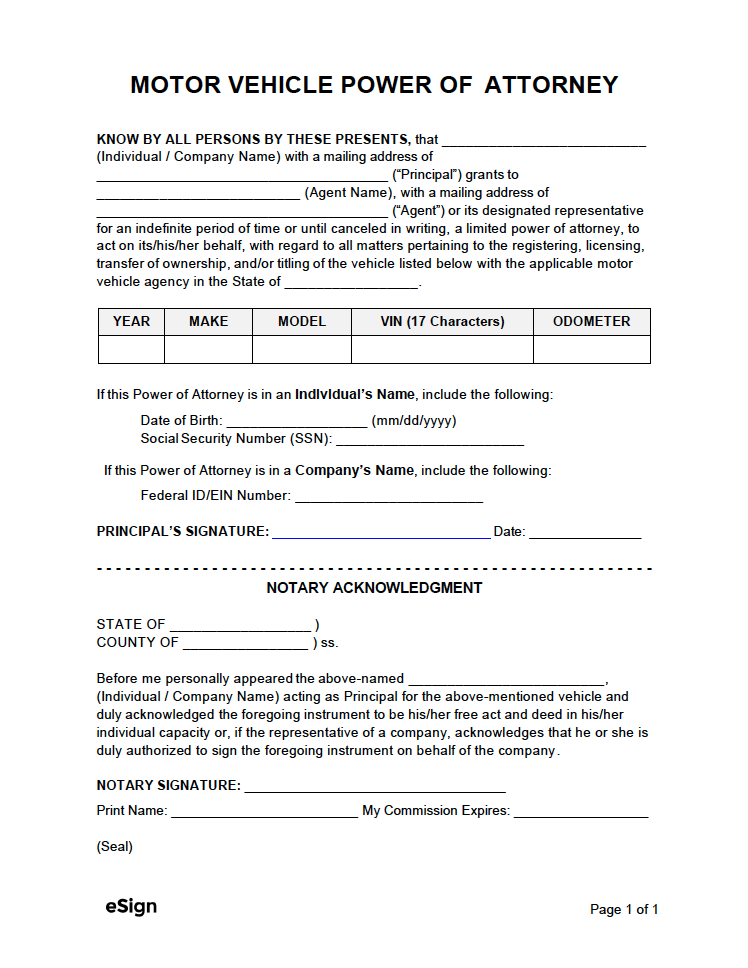Document Features
- Designation – Enables the principal to appoint a representative to manage vehicle matters such as registration, licensing, and titling.
- Flexibility – Establishes indefinite authorization, allowing the agent to act on the principal’s behalf until the power of attorney is cancelled.
- Clarity – Includes the appropriate vehicle information so third parties can clearly identify the vehicle.
- Transparency – Outlines the agent’s powers and includes the principal’s signature, ensuring the document’s validity.
By State
- Alabama
- Alaska
- Arizona
- Arkansas
- California
- Colorado
- Connecticut
- Delaware
- Florida
- Georgia
- Hawaii
- Idaho
- Illinois
- Indiana
- Iowa
- Kansas
- Kentucky
- Louisiana
- Maine
- Maryland
- Massachusetts
- Michigan
- Minnesota
- Mississippi
- Missouri
- Montana
- Nebraska
- Nevada
- New Hampshire
- New Jersey
- New Mexico
- New York
- North Carolina
- North Dakota
- Ohio
- Oklahoma
- Oregon
- Pennsylvania
- Rhode Island
- South Carolina
- South Dakota
- Tennessee
- Texas
- Utah
- Vermont
- Virginia
- Washington
- West Virginia
- Wisconsin
- Wyoming
Common Uses for a Vehicle POA
- Buying or selling a motor vehicle
- Registering a car or truck
- Applying for a certificate of title
How a Motor Vehicle POA Works
A motor vehicle power of attorney appoints an individual, called the “agent” or “attorney-in-fact,” to act on someone else’s behalf in vehicle-related matters such as registration, sales, and title transfers. Most state DMVs require that the agent bring the document with them when representing the owner.
Vehicle owners should use a state-specific form to ensure it will be accepted by the DMV.
How to Use
The step-by-step guide below explains how individuals can prepare and use a power of attorney form for motor vehicle transactions.
Step 1 – Collect Information
The principal will usually need the following information when filling out a motor vehicle power of attorney:
- Vehicle details (make, model, year, VIN, etc.)
- Current odometer reading
- An identification number, such as a driver’s license or state-issued ID number
Depending on the POA’s intended use, the vehicle’s registration, title, proof of insurance, or license plates may also be needed.
Step 2 – Select Agent and Powers
The chosen agent must be at least 18 years old and should be someone the principal trusts, as they may have the authority to transfer ownership. The exact powers granted to the agent (registration, title transfer, etc.) will be specified in the POA form.
Step 3 – Sign
A motor vehicle POA must be signed by the principal and should be notarized, even if not required by state law.
Step 4 – Agent Completes Tasks
The agent must present the completed POA at the DMV or applicable office to carry out their assigned duties. When signing on the principal’s behalf, they should add “POA” next to their signature. All documents and receipts obtained while acting as the agent should be saved for the principal’s records.
Sample
Download: PDF (Blank) | PDF (Sample Data)
MOTOR VEHICLE POWER OF ATTORNEY
KNOW BY ALL PERSONS BY THESE PRESENTS that [PRINCIPAL NAME] with a mailing address of [PRINCIPAL ADDRESS] (the “Principal”) grants to [AGENT NAME], with a mailing address of [AGENT ADDRESS] (the “Agent”) or its designated representative for an indefinite period of time or until canceled in writing, a limited power of attorney, to act on its/his/her behalf, with regard to all matters pertaining to the registering, licensing, transfer of ownership, and/or titling of the vehicle listed below with the applicable motor vehicle agency in the State of [STATE].
Vehicle Description: [MAKE, MODEL, YEAR, VIN] Odometer Reading: [# OF MILES]
Principal’s Signature: ______________________ Date: [MM/DD/YYYY]
NOTARY ACKNOWLEDGMENT
STATE OF [STATE]
COUNTY OF [COUNTY]
Before me personally appeared [PRINCIPAL NAME], acting as Principal for the above-mentioned vehicle and duly acknowledged the foregoing instrument to be his/her free act and deed in his/her individual capacity or, if the representative of a company, acknowledges that he or she is duly authorized to sign the foregoing instrument on behalf of the company.
Notary Signature: ______________________
Print Name: [NOTARY NAME]
My Commission Expires: [MM/DD/YYYY]
(Seal)





